Floor Reflections and Scary Curves
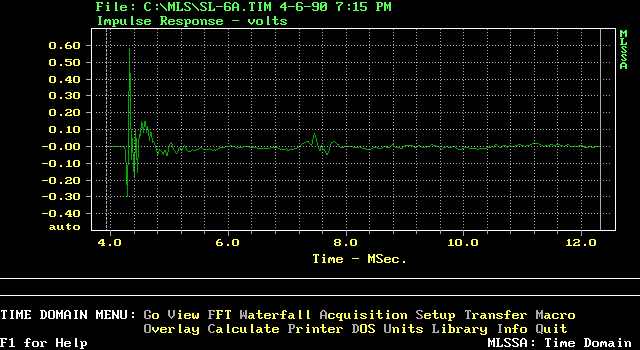
Here's our old friend, the Celestion SL-6, the speaker that opened up the MLSSA Gallery. I chose this example because it shows a very well-designed commercial speaker with the smallest radiating area of any of the speakers shown here - it's the closest thing to a point source in this group.
A side effect of the small source size is a very sharp and well-defined floor bounce, which is attenuated and low-pass filtered compared to the first-arrival sound. Since this measured in a hi-fi shop, there wasn't the opportunity to gather 2 feet of assorted cushions, pillows, and blankets I usually borrow when at home.
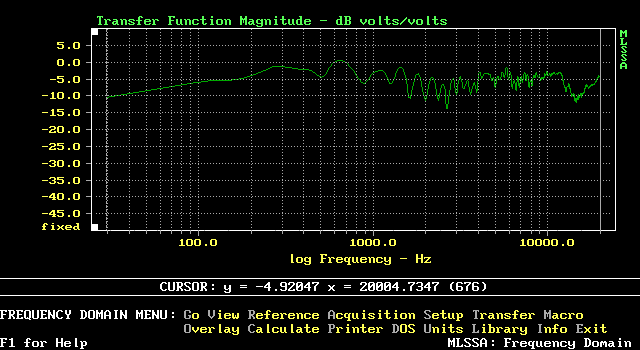
If a you want a nice example of comb filtering, here you are. Two crisply-defined sources, one delayed by 3.2 milliseconds, produce the periodic nulls that start at 500 Hz and works its way up the spectrum - 900 Hz, 1.3 kHz, 1.8 kHz and so on.
As mentioned earlier, although annoying to measure - since it disguises the performance of the speaker - this is what we expect to hear in the real world. Just about every time you hear a speaking voice, the source is physically small - smaller than a loudspeaker - and there's a floor bounce that accompanies it as well.
This is also a true at a music recital. Many of the instruments are physically smaller than a loudspeaker, and there's a reflection off the hard wooden floor. Carpets under the musicians are unwelcome; the sound bouncing off the hard wooden floor is part of the sound of the instruments. Even bandstands located outdoors have hard-surfaced floors.
Interestingly, the one way to remove most of the floor bounce from a recording is to close-mike the instrument or singer. When you play back the recording, the loudest floor bounce isn't going to be the one in the studio, but the one in the listening room. A large-surface speaker blurs this reflection, and a small point-source speaker leaves it similar to the real-world event - which we are expecting to hear.
Listening to a symphony, of course, is completely different, since the orchestra is predominantly picked up by distant microphones that cover the whole orchestra, with "spot" mikes for key instruments and soloists. In the listening room, the floor bounce overlays the entire orchestra - and again, the physical size of the speaker controls how diffuse the floor reflection is going to be. With horns, it gets interesting, since the vertical dispersion can be quite different for different horns covering different frequency ranges, leading to a floor reflection with quite a different spectra than the first-arrival sound.
I bring up these arcane items just to show that there's a lot that's not taken into account with an simple frequency-response graph made in an anechoic chamber, or a real-time analyzer measurement made with 1/3 octave filtered pink noise in a room. Something as simple as a floor reflection is a part of our everyday life, a built-in part of our acoustic environment. It also affects how we measure a speaker, and how that speaker sounds with recordings made with different microphone techniques.
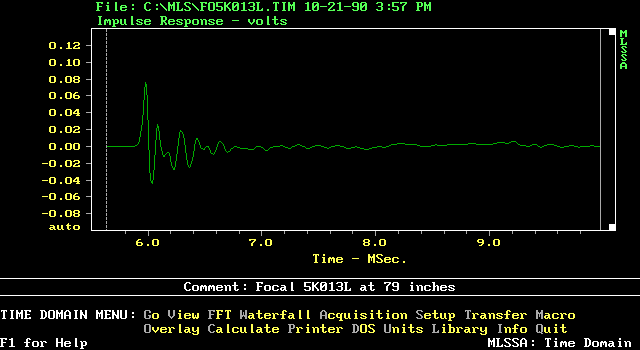
Here's where things get ugly. Measured on a IEC flat baffle, here is the impulse response of a popular Kevlar driver used in more than one $50,000-and-up loudspeaker with a Stereophile Class A rating. The hideous curves - and sonics - are why I've been avoiding these things, along with other exotic cone materials like carbon-fiber, multilayer composites, metals, etc. etc.
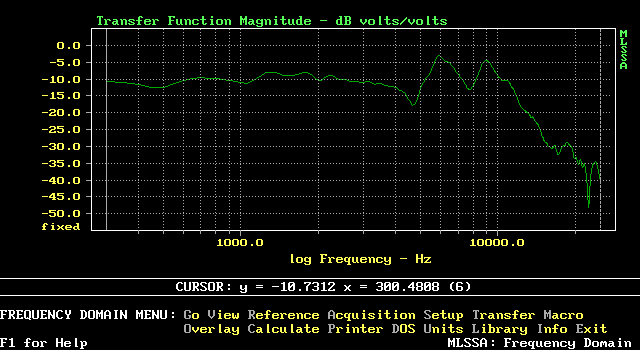
The two severe resonances at 5.9 and 9 kHz do not lend themselves to crossover filtering; if there was just one, say at 5.9 kHz, then a notch filter followed by a fairly steep rolloff would do the job. With two resonances this close to each other, paired notch filters have very sensitive tuning, requiring a set of filters individually hand-matched to each driver, no assurance it will stay in tune over time, and a very complex and costly crossover in parts cost and production time. In practice, it's not practical to correct two closely spaced high-Q peaks like we see here.
This driver became popular at the same time as minimalistic crossovers, so there are expensive high-end speakers that make no attempt at all to correct the two huge resonances. I surmise other manufacturers that use this distinctive-looking driver (with its bright yellow cone) just use a 24dB/octave lowpass filter at 3kHz and hope for the best.
On audition, with no crossover and mounted on the large open baffle, the driver sounds harsh and gritty. I'd prefer an old paper-cone driver out of a 1961 console Motorola color TV; it measures bad, sounds bad, and is also quite expensive. It says something about the high end industry that it, and many drivers like it, became so popular and were highly reviewed.
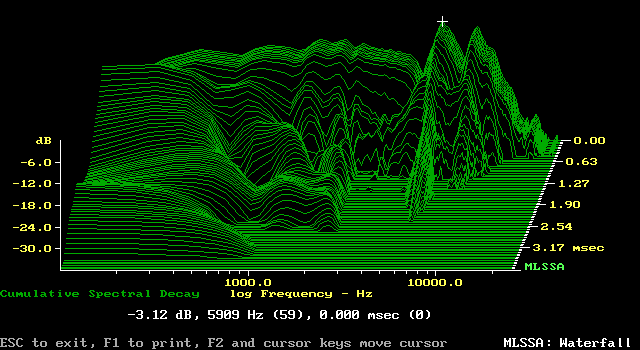
It's been my experiece that resonances of this magnitude, and a Q this sharp, are readily audible even with 30dB of rolloff applied. A steep crossover rolloff makes the overall curve look good - the peaks are disguised up by the response from the tweeter - but the low-level resonances are still quite audible as harshness, grain, flattening of the soundstage, and an overall "mechanical" sound that is quite fatiguing.
If a notch filter is applied and precisely tuned to the resonance - remember, a mistuning error makes it worse - it can be subjectively "dropped out". An A/B switch on pink noise is the best way to confirm complete removal.
But even with notch filters, there's no free lunch. With the peak completely removed from the frequency and time domain, it still appears on the distortion spectrum (where it cannot be corrected). So there's always a residue of audibility, despite the miracle of equalization. The residue on a fully-corrected driver sounds like a "grey" coloration, a frequency region that appears tonally flat and colorless. I learned this the hard way with the over-equalized speakers I designed back in my Audionics days.
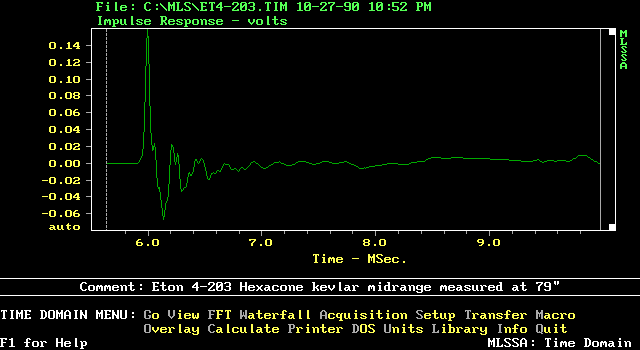
This Eton 4-inch driver has been popular in ultra high-end speakers, thanks to the exotic composite cone, which we'd expect would have better damping than a straight Kevlar or carbon-fiber cone. There is a fair amount of fine-grained jaggedness in the time response; remember, this is mounted off-center on a large flat baffle, measured with a low-diffraction microphone flat to 40 kHz, and lowpass filtering in MLSSA with a 25 kHz Bessel filter. Any roughness we see is in the driver.
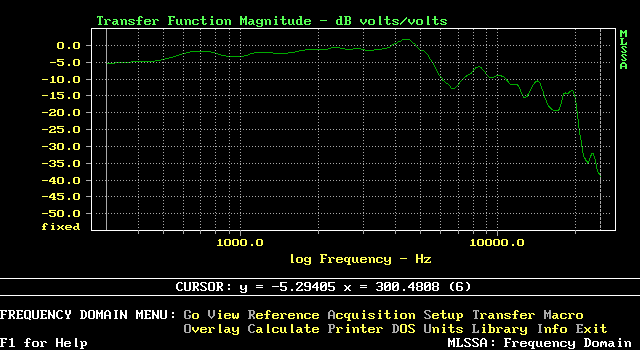
The frequency response is thankfully much better than the Kevlar driver, showing the damping techniques are indeed working. The bump-and-notch is going to make the crossover design a little tougher, though. Using a notch filter at 4.5 kHz will certainly deal with the resonance, and will probably clean up the waterfall you see below - all good things to do - but the notch at 7.5 kHz and following rise at 8.5 kHz are somewhat troubling. About all that can be done here is apply a high-slope filter and accept the phase deviations this leaves behind.
This driver, although very wideband, does not have what I'd call a smooth rolloff. On audition without a crossover, sounds open and "fast" but still a bit on the rough side. This is something I haven't mentioned earlier; when a wideband driver is on a big test baffle, go ahead and listen to it! Use a high-quality amplifier, a wide variety of musical sources, and get acquainted with the basic character of the driver. No matter how fancy your crossover and cabinet will be, you'll never change the basic character of the driver. It'll always be there, so you better like it before you start doing the hard part.

One thing that's a little weird in this waterfall display is the Eton 4-203's resonance shifts frequency as it fades away. It starts at 4.5 kHz at T=0, and works its way up to 5 kHz by 1.5 mSec. The frequency-modulation curve is just barely visible in the display, since it is at a slight angle to the other resonances at higher frequencies.
This is a prime example why it's just plain wrong to assume a driver can be accurately modelled by RLC networks. No way on God's Green Earth can you build a passive RLC filter that behaves the way you see in this graph, with the resonant frequency moving upwards as it decays, almost like a frequency chirp. In practical terms, you'd have to build the 4.5~5 kHz notch filter, view it in the waterfall display, and subjectively tune it for the smoothest sound on pink noise. The best tuning for impulse response is probably not going to be the best tuning for musical structures that stretch out in time.
This kind of unexpected frequency modulation also appears in the decay of partials in pianos and other musical instruments, and is the reason "automatic" tuners may not give the desired sound. You can also see when the frequency-modulated partial of a piano slides across the (fixed) resonance of a loudspeaker, you're going to get some rather odd sum-and-difference cancellation effects that will most certainly affect the tonal character of the piano.
Text and Pictures © Lynn Olson 2006.